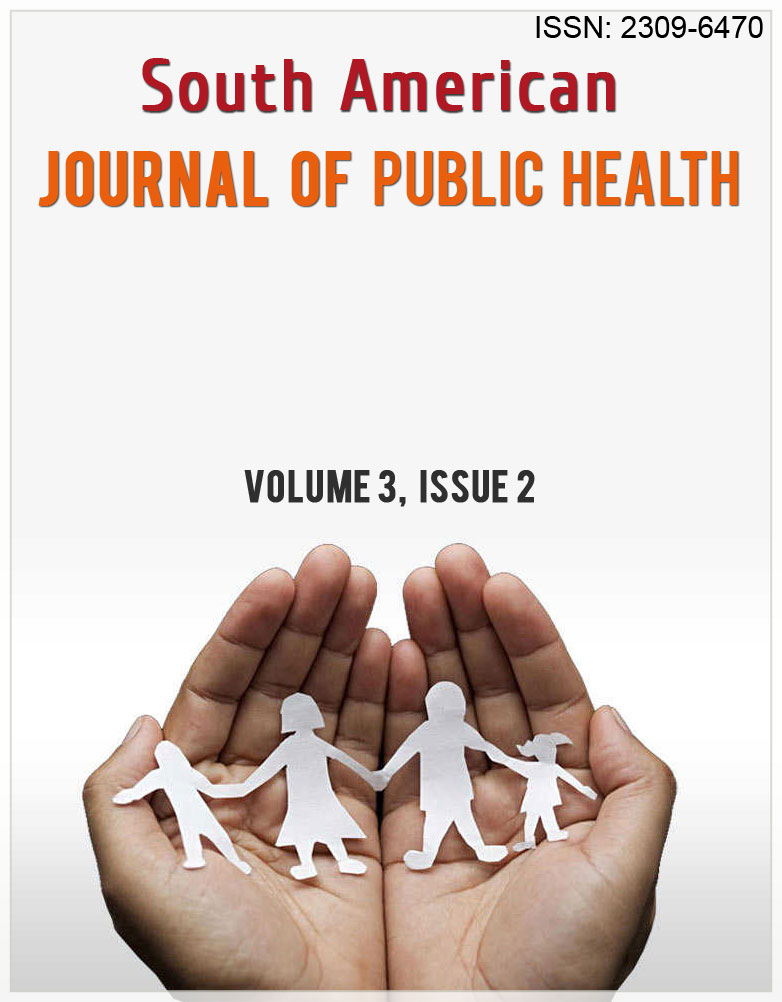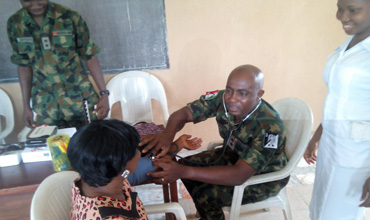References:
1. Abimbola S. How to improve the quality of primary health care in
Nigeria. 2012. BMJ. http://blogs.bmj.com/bmj/2012/06/22/seye-abimbola-how-to-improve-the-quality-of-primary-health-care-in-nigeria/.
Accessed 29/04/15
2. Adetunji JA. Response of parents to five killer diseases among
children in a Yoruba community, Nigeria. Soc Sci Med 1991; 32:1379-1387.
3. Adikwu MU. Sales practices of patent medicine sellers in Nigeria.
Health Policy Planning. 1996; 11(2):202–205.
4. Africa Health Workforce Observatory [AHWO] (2008) Human Resources
for Health Country Profile: Nigeria. Geneva: World Health Organization
5. Amooti-Kaguna B, Nuwaha F. Factors influencing choice of delivery
sites in Rakai district of Uganda. Soc Sci Med 2000; 50: 203-13.
6. Awodele OI, Adeniran A, Awodele DF. Pharmacovigilance amongst
patent medicine vendors (PMVs) in Ekiti state, Nigeria. Int J Risk Saf Med.
2012; 24 (2): 65-72. doi: 10.3233/JRS-2012-0562.
7. Baker JB, Bazemore AW, Jacobson CJ. Rapid Assessment of Access to
Primary Care in Remote Parts of the Developing World. Field Methods 2008; 20
(3): 296–309. DOI: 10.1177/1525822X08317114. http://shouldertoshoulder.org/wp-content/uploads/2013/03/s2s_primary_care_access_assessment.pdf.
Accessed 29/04/15
8. Barnes J, Chandani T, Feeley R (2008) Nigeria Private Sector
Health Assessment. Bethesda, MD: Private Sector Partnerships-One project, Abt
Associates Inc.
9. Beyeler N, Liu J, Sieverding M. A Systematic Review of the Role of
Proprietary and Patent Medicine Vendors in Healthcare Provision in Nigeria.
PLoS ONE 2015; 10(1): e0117165. doi:10.1371/journal.pone.0117165
10. Brieger WR, Osamor PE, Salami KK, Oladepo O, Otusanya SA.
Interactions between patent medicine vendors and customers in urban and rural
Nigeria. Health Policy Plan 2004; 19:177-182.
11. Brieger W, Unwin A, Greer G, Meek S. Interventions to improve the role
of medicine sellers in malaria case management for children in Africa. London,
UK and Arlington, Va., USA: the Malaria Consortium and BASICS for the United
States Agency for International Development; prepared for Roll Back Malaria's
Sub-group for Communication and Training and Malaria Case Management Working
Group; 2005.
12. Brugha R, Zwi A: Improving the quality of private sector
delivering of public health services: challenges and strategies. Health Policy
Plan 2002; 13: 103-120.
13. Delta State, 2015. http://www.deltastate.com.ng/Delta-Articles/local-government-areas.html.
Accessed 1/5/15.
14. Egboh A. Pharmacy laws and practice in Nigeria. Ikeja: Literamed
Publications; 1984.
15. Erhun OO, Babalola MO, Erhun WO. Drug regulation and control in
Nigeria: The challenge of counterfeit drugs. Journal of Health & Population
in Developing Countries 2001; 4: 23-34.
16. Foster SD. Pricing, distribution, and use of antimalarial drugs.
Bull World Health Organ 1991; 69: 349-363.
17. Frankenberg E. The effects of access to health care on infant
mortality in Indonesia. Health Transit Rev 1995; 5: 143-63.
18. Grais RF, Dubray C, Gerstl S, Guthmann JP, Djibo A, Nargaye KD, et
al. Unacceptably high mortality related to measles epidemics in Niger, Nigeria,
and Chad. PLoS Med 2007; 4: e16.
19. Iweze EA. The patent medicine store: hospital for the urban poor.
In The urban poor in Nigeria. Edited by Makinwa PK, Ozo OA. Ibadan, Nigeria:
Evans Brother Ltd; 1987:317-322.
20. Jones G, Steketee RW, Black RE, Bhutta ZA, Morris SS, Bellagio
Child Survival Study Group. How many child deaths can we prevent this year?
Lancet 2003; 362: 65-71.
21. Kadobera D, Sartorius B, Masanja H, Mathew A, Waiswa P. The effect
of distance to formal health facility on childhood mortality in rural Tanzania,
2005-2007. Glob Health Action (Global Health Action) 2012; 5: 1-9.
22. National Population Commission, National Malaria Control
Programme, ICF International (2012) Nigeria Malaria Indicator Survey 2010 Abuja,
Nigeria: NPC, NMCP and ICF International; doi:
10.1016/j.asjsur.2012.06.01025554668
23. National Primary Health Care Development Agency (2011) Draft
Essential Childhood Medicines Scale-Up Plan Abuja, Nigeria: Federal Ministry of
Health; doi: 10.1080/17437199.2011.58796125473706
24. Nwangwu PU. Health care delivery in Nigeria: contributions of
Nigerians in diaspora. Address to the convention of Nigerian professionals in
diaspora, at Paris, France. Accessed 15/04/2015.
25. Okonkwo AD, Okonkwo UP. Patent medicine vendors, community
pharmacists and STI management in Abuja, Nigeria. (African Health Sciences) Afr
Health Sci. 2010; 10(3): 253–265.
26. Onwujekwe O, Onoka C, Uzochukwu B, Hanson K. Constraints to
universal coverage: inequities in health service use and expenditures for
different health conditions and providers. Int J Equity Health 2011;10: 50 doi:
10.1186/1475-9276-10-5022078263
27. Peterson K, Obileye O. Access to drugs for HIV/AIDS and related
opportunistic infections in Nigeria. Policy Project/Nigeria. 2002:1–45.
28. Ross-Degnan D, Goel P, Berman P, Soumeari S. Retail pharmacies in
developing countries: A behaviour and intervention framework. Social Science
& Medicine. 1996;42(8): 1155–1161.
29. Say L, Raine R. A systematic review of inequalities in the use of
maternal health care in developing countries: examining the scale of the
problem and the importance of context. Bull World Health Organ 2007; 85:
812-19.
30. Starfield B, Shi L, Macinko J. 2005. Contribution of primary care
to health system and health. Milbank Quarterly 83 (3): 457–502.
31. Sule SS, Ijadunola KT, Onayade AA, Fatusi AO, Soetan RO, Connell
FA. Utilization of primary health care facilities: Lessons from a rural
community in southwest Nigeria. Nigerian Journal of Medicine 2008; 17 (1):
98-106.
32. Sunday A. Adedini, Clifford Odimegwu, Olusina Bamiwuye, Opeyemi
Fadeyibi and Nicole De Wet. Barriers to accessing health care in Nigeria:
implications for child survival. Glob Health Action 2014; 7: 23499 - http://dx.doi.org/10.3402/gha.v7.23499
33. Thaddeus S, Maine D. Too far to walk: maternal mortality in
context. Soc Sci Med 1994; 38: 1091-110.
34. World Bank. 2008. Nigeria—Improving Primary Health Care Delivery:
Evidence from Four States. Washington, DC. © World Bank. https://openknowledge.worldbank.org/handle/10986/7784
License: CC BY 3.0 Unported.”
35. World Health Organization, 1986. Ottawa Charter for Health
Promotion. Geneva: World Health Organization, 1986 (WHO/HPR/HEP/95.1)
36. World Health Organization, 1990. The role of the pharmacist in the
health care system. Report of WHO. Action Programme on Essential Drugs and Unit
of Pharmaceuticals consultative group, New Delhi, 13–16 December 1988. Geneva:
WHO; 1990.
37. World Health Organization, 1997a. Public-private roles in the
pharmaceutical sector: Implications for equitable access and rational drug use.
Geneva World Health Organization 1997a. WHO/DAP/97.12
38. World Health Organization, 1997b. Public education in rational
drug use. Geneva: WHO; 1997b. WHO/DAP/97.5.
39. World Health Organization 2009. Milestones in Health Promotion:
Statements from Global Conferences. Geneva: World Health Organization, 2009.
WHO/NMH/CHP/09.01
40. World Health Organization, 2015. Global Health Workforce Alliance.
http://www.who.int/workforcealliance/countries/nga/en/.
Accessed 29/04/15
41. World Health Organization/United Nations Children's Fund, 1978.
Primary Health Care, Alma Ata 1978. ‘Health for All’ series no. 1. Geneva:
World Health Organization, 1978

 Prevalence and Factors Associated with Obesity and Overweight Among Pensioners In The Eastern Region Of GhanaAuthor: Benjamin Demah Nuertey
Prevalence and Factors Associated with Obesity and Overweight Among Pensioners In The Eastern Region Of GhanaAuthor: Benjamin Demah Nuertey Knowledge, Attitude and Practice of Physical Activity Among Health Professionals in A Nigerian Tertiary Health InstitutionAuthor: Samuel Olufemi Bolarinde
Knowledge, Attitude and Practice of Physical Activity Among Health Professionals in A Nigerian Tertiary Health InstitutionAuthor: Samuel Olufemi Bolarinde Factors Contributing to Non-Adherence to Medical Ethics by Health Workers at Ndola Central Hospital, Ndola, ZambiaAuthor: Ellen Mutinta Munyati
Factors Contributing to Non-Adherence to Medical Ethics by Health Workers at Ndola Central Hospital, Ndola, ZambiaAuthor: Ellen Mutinta Munyati A Study of Issues Relating to Communication Problems among Patients and Care Providers in District HospitalAuthor: Sanjay Kumar Singh
A Study of Issues Relating to Communication Problems among Patients and Care Providers in District HospitalAuthor: Sanjay Kumar Singh Quality Assurance and Self-Assessment: Approach Methods by Southern UniversityAuthor: Emmanuel Hakwia Kooma
Quality Assurance and Self-Assessment: Approach Methods by Southern UniversityAuthor: Emmanuel Hakwia Kooma Improving Access to Health Care in Rural Communities by Re-Orienting and Integrating Patent Medicine Sellers into Primary Health Care Service Delivery in NigeriaAuthor: Okumagba Mamodesan
Improving Access to Health Care in Rural Communities by Re-Orienting and Integrating Patent Medicine Sellers into Primary Health Care Service Delivery in NigeriaAuthor: Okumagba Mamodesan Application of Epidemiology in Diabetes Mellitus in Sub Saharan Africa: Screening of Diabetes MellitusAuthor: Pasipanodya Ian Machingura
Application of Epidemiology in Diabetes Mellitus in Sub Saharan Africa: Screening of Diabetes MellitusAuthor: Pasipanodya Ian Machingura
